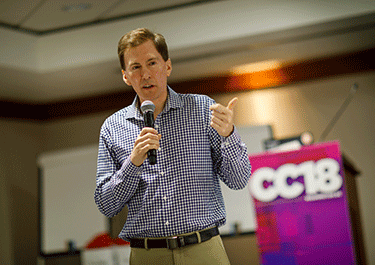 Innovation can be defined as “a viable offering that is new to a specific context and time, creating user and provider value” – this according to Indian roboticist Vijay Kumar.
Innovation can be defined as “a viable offering that is new to a specific context and time, creating user and provider value” – this according to Indian roboticist Vijay Kumar.
With this in mind, the CompTIA Managed Services Community’s Executive Council brought expert Peter Zapf of Fog Pilot to the community’s forum, The First Idea: Becoming Deliberately Creative, at CompTIA ChannelCon 2018 earlier this month at Marriott Wardham Park in Washington, D.C.
Zapf is a design planner focused on helping organizations realize innovation through a values-driven design process. As design planning lead, he facilitates strategic planning, brand design, creative problem solving and innovation workshops. At ChannelCon, he said creativity isn’t just the property of marketing, advertising and R&D. If you solve problems, pursue opportunities or take on challenges, you engage in the creative process. Some technical people discount their own creativity. Could learning to be deliberately creative help businesses of all sizes drive innovation?
According to Zapf, a valuable idea is desirable, feasible and viable. As the tech ecosystem continues to evolve, expand and morph, thriving requires innovation. What to sell, how to service and what customers will use it for are just the beginning of the questions for players in the tech industry. Plus, the business of technology is bringing in new players daily. Learning how to develop valuable ideas is a skill that can be learned and constantly improved. There are a couple things to be established first.
One is to squash the business-as-usual mentality. Second decide “the why” and set your values. Humans make judgments based on their values and if everyone doesn’t understand the values of the organization, coming together will be much harder. Zapf said an easy question to help establish values is “What will [we] be remembered for? What will [our] tombstone say?” Insist everyone use empathy, as exploring others’ viewpoints expands understanding and triggers more than ideas. Last remember every stage has two modes of thinking; exploring options and making decisions. Separate those modes.
Zapf prescribed the following four steps to creativity:
Step 1: Be deliberately creative. Think divergently. Explore options. Defer judgement. Strive for quantity. Seek wild and unusual ideas. Don’t use “No, but…” Use “Yes, and…”
Step 2: Use affirmative judgement. Be deliberate. Work to improve options. Be open to novelty. Revisit objectives. Look first at how an idea could work.
Step 3: Evaluate ideas. Start with the positives of an idea. Explore the opportunities each idea presents. Imagine how the idea could have an impact on the future. Phrase issues as a question, like, “How might we…?”
Step 4: SCAMPER: Substitute, Combine, Adapt, Modify, Put to another use, Eliminate, Reverse. Take all ideas through this process to arrive at an innovative, valuable idea.
In an era of perpetual disruption, being deliberately creative is a skill-set that leaders in the tech industry may want to consider. Employees are the folks who know your clients’ wants, needs and, even more importantly, wishes best. Developing a culture of deliberate creativity where no one is afraid to share an idea, no matter how novel, might just be the key to breaking the barriers to growth.
Click here to get full coverage of ChannelCon 2018 and here to get involved in CompTIA’s Managed Services Community.

 Add CompTIA to your favorite RSS reader
Add CompTIA to your favorite RSS reader

